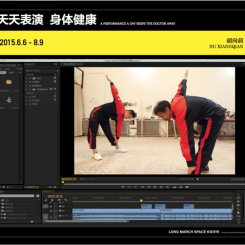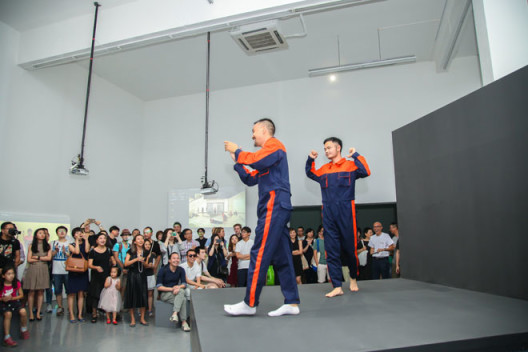Hu Xiangqian: A Performance A Day Keeps the Doctor Away
Long March Space (Beijing 798 Art Zone) June 6 – August 9, 2015
Hu Xiangqian’s artistic practice derives from a subtle relationship between current events and personal experience. One of his video works, “Blue Flags Everywhere”, documents the artist’s experience running for the mayoral seat of his hometown at the age of 21 with a sense of humour not entirely devoid of earnestness . In “Sun”, he attempts to tan his skin to a similar shade as that of two close African friends. Hu Xiangqian recently held a solo exhibition at Long March Space. Here, Yuan Fuca speaks to the artist about the issues of performance in video, as well as art and affect.
Yuan Fuca (YF): Did you have any previous experience with the martial arts movements in the film “The Secret Mission”?
Hu Xiangqian (HX): I knew a bit from kendo. I used kendo in “The Secret Mission”. I don’t know how to use a one-handed blade, so I used a Song Dao (a sword used during the Song Dynasty). A Song Dao is used in a style very similar to kendo; as a matter of fact, I think the style was circulating around that time period.
YF: Why is the archetype of the gallant hero so important to you?
HX: I love wuxia novels. They describe the gallant hero as transcendent and god-like. But perversely enough, my work does not express this superficial image of gallantry. In fact, the gallant hero I play is rather wimpy—he more closely resembles the spiritually gallant character described by Taiwanese author Kung Pengcheng; he lives the miserable life of a jobless itinerant. He’s not exciting, and he’s not great or admirable in any way, but there remains the possibility that he might accomplish something.
YF: Wuxia novels frame gallant heroes as these superb, mystical figures, creating the identity of an archetypal hero. It could even be said that such elements of performance penetrate their entire existence
HX: Everyone is really playing their own roles, and gallant heroes are no exception. You have to have an outline of a story if you’re going to make such a film. I didn’t want it to be like one of those baffling, early-stage experimental films, but I also didn’t want it to be as plot driven by a movie format. So I decided there would be a story, but a very boring one devoid of any unique rising or falling action. This way, a viewer who goes into it anticipating a plot might focus on images, superficial performances, minute movements and other such details.
YF: Was the slow pacing deliberate throughout the film?
HX: Yes, I kept the pacing slow because I wanted to distance it from a movie. Movies are fast paced. That horseback riding scene in my film went on for several minutes. It more closely resembles performance art than cinematic performance. In fact, it’s more of a performance of the body. Each section of a movie is very goal-oriented, but that doesn’t exist here. Even if there is a goal, it is derided by the camera lens. For example, in most horseback riding scenes, once you arrive at your destination, some sudden event usually takes place, but in my film nothing happens. I think this process is very subtle. When I was doing it and filming it, I wanted it to resemble performance art. This was a very clear goal.
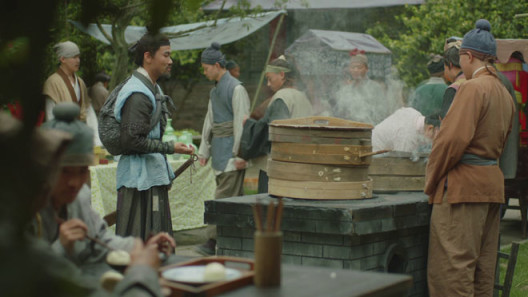
Hu Xiangqian, “The Secret Mission”, video
胡向前,《秘密任务》,录像(Courtesy: the artist and Long March Space 鸣谢:艺术家及长征空间)
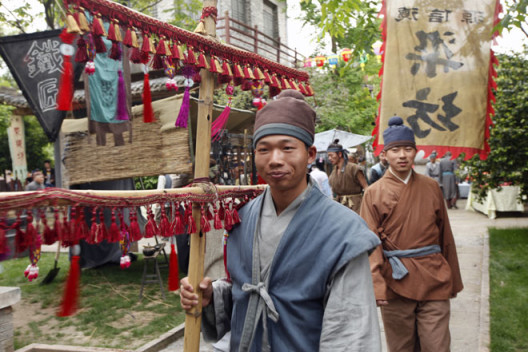
Hu Xiangqian, “The Secret Mission”, video
胡向前,《秘密任务》,录像(Courtesy: the artist and Long March Space 鸣谢:艺术家及长征空间)
YF: Intentional acts like these are further magnified on film. The flow of time at a performance site is totally different from time in a video work. Occasionally, it even overtakes time. If you walk back and forth during a performance, the actual time you spend walking will not be longer than the time it takes to watch a video clip of equal length. It makes me think of that performance piece where Chris Burden was lying down on the bed, and he could barely stand it towards the end. But when you watch the film, I felt that the film had a more accurate grasp of the temporal nature of the performance.
HX: Right. That’s why I use these cinematographic and videographic methods to do performance art. Performance is very interesting—it’s on site, it has many advantages, and it’s very different from other categories of art—but it also has many flaws. I want to use this method of editing together clips to see if I can achieve what I want.
YF: For this exhibition, you’ve chosen to present the timeline of video work, even the stage for the live performance is a timeline.
HX: This is meant to emphasize the relationship between the work and space. I wanted to transform the work itself into a space. While I was editing the film, I felt as if I was living in a framework. In addition, I wanted to transform the exhibition space into a wall papered, physical space with a strong visual impact immediately upon entry. The axis of time is much like a stage; it’s very logical to use it as a stage for a real performance. Many elements intersect at different times.

Hu Xiangqian, “Stick Diagram”, video still
胡向前,《棍谱》,视频截屏(Courtesy: the artist and Long March Space 鸣谢:艺术家及长征空间)
YF: “Reconstructing Michelangelo” was an important part of the structure of this exhibition. How did you come up with this title?
HX: There were many reasons. First, the process of making this piece was very sculptural; the way I changed Shao Zhenxing and how he changed me resembled the process of moulding and creating a sculpture. Second, the master/apprentice relationship was a really great one in the past; such bonds still exist, but they are not as strong. Third, Michelangelo was a great apprentice. He was once an apprentice too. I’m obsessive. I want everyone to do art. Art is fun. Shao was born in 1990; he had the best understanding of art in his class, and he has a good foundation in contemporary art history. He wants to be an artist. Someone who was totally uninterested in art would not come near it. Everything happens for a reason.
YF: Shao’s first work was a performance piece. What was your thinking about that? Performance art has been around since Futurism; it’s been a hundred years. What is the current status of performance within contemporary art?
HX: Yes. It hasn’t been around for long, and it’s difficult to popularize. Of course, I want more people to do it, but I think that overall, progress has been slow. I saw a lot of performance in New York, and I rarely saw anything good. Most of the performances were about the body, with a totally different understanding of the body from ours. Some of the performances they were doing on stage looked very classical to me; they seemed very natural, but it’s hard for Chinese people to do these things. How Chinese people view the human form is culturally very different. We have a very different understanding of it. We do not encourage exposure of the body, nor do we encourage exposure of our selves. Our culture does not encourage such things, but performance art is about exposing oneself.
YF: Yet you gravitated towards this method of extraversion very early on, as seen in some of your practice during university.
HX: That’s right. I enjoyed giving speeches and telling stories from an early age. When I was very young, I read more books than other kids my age. I would tell my friends stories of rich landowners and things like that, so I had a lot to say. There’s not a lot of cultural tradition in southern China, but there was something of a literary background in my family when I was young. Although my father was a farmer, he had a bit of culture. So I seemed to know more than my friends, and they always asked me to tell them stories. We had story meetings. Didn’t you always do that kind of thing when you were little? So I’d tell them stories. Then, in middle school, I got on stage to perform even though I didn’t speak standard Mandarin. I made all kinds of speeches about loving my country, resisting the Japanese, etc. So I had some experience performing from a young age.
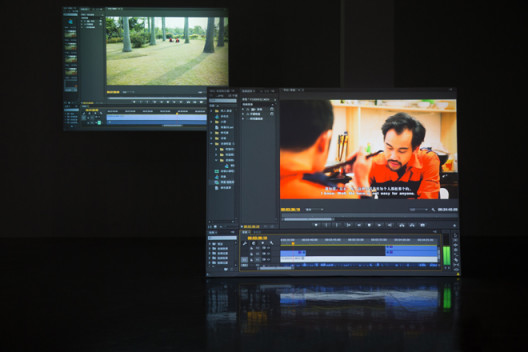
Hu Xiangqian, “Reconstructing Michelangelo” series, video screenshot
胡向前,《再造米开朗基罗》,录像截屏(Courtesy: the artist and Long March Space 鸣谢:艺术家及长征空间)
YF: You’ve also included your exploration of performance in these works.
HX: I’d really like to make a so-called “breakthrough” in performance, to show people the possibility of broader, more liberal and more genuine progress. I’d like to take the focus off the body or site-specific performances. We could incorporate painting or other media. But a lot of people don’t see it this way; they have a very rigid definition of performance. It might also be good to pursue something to the bitter end like Tino Sehgal, but I also feel his methodology hasn’t resulted in any development, despite the progress he has made for performance.
YF: I think it’s a problem of description. Most of the time, people are talking about performativity, which creates a kind of identity, whether it’s in the scope of anthropology or the so-called “encoded” identities we have now. Whether it’s because the definition is too narrow or it’s because our understandings of the body differ, what do you think is the reason we lack works with affect? After all, Tino Sehgal’s works have affect, and yours do as well.
HX: Yes. Affect is quite important. There are more rational pieces, because everyone is afraid they might lose something. They also fear failure. Art trends back and forth. For a time, the emphasis might have been on sensibility, and then everyone suddenly feels like they were meaningless after all, and return to the framework of rationality while congratulating themselves on being cool. Then they might revert. Actually, people are always colliding with affect. I admit this thing you are talking about—yes, it’s truly very important.

Hu Xiangqian, “Reconstructing Michelangelo” series, video
胡向前,《再造米开朗基罗》,录像(Courtesy: the artist and Long March Space 鸣谢:艺术家及长征空间)

